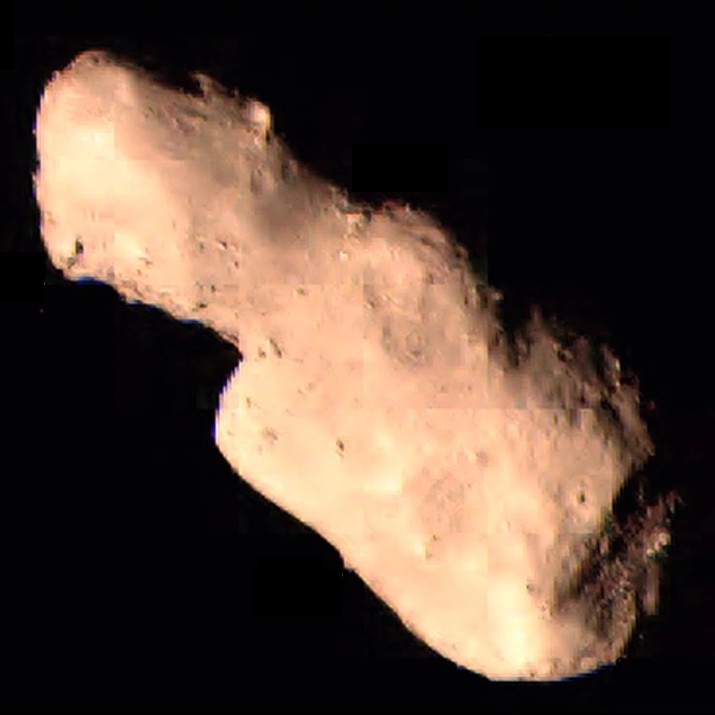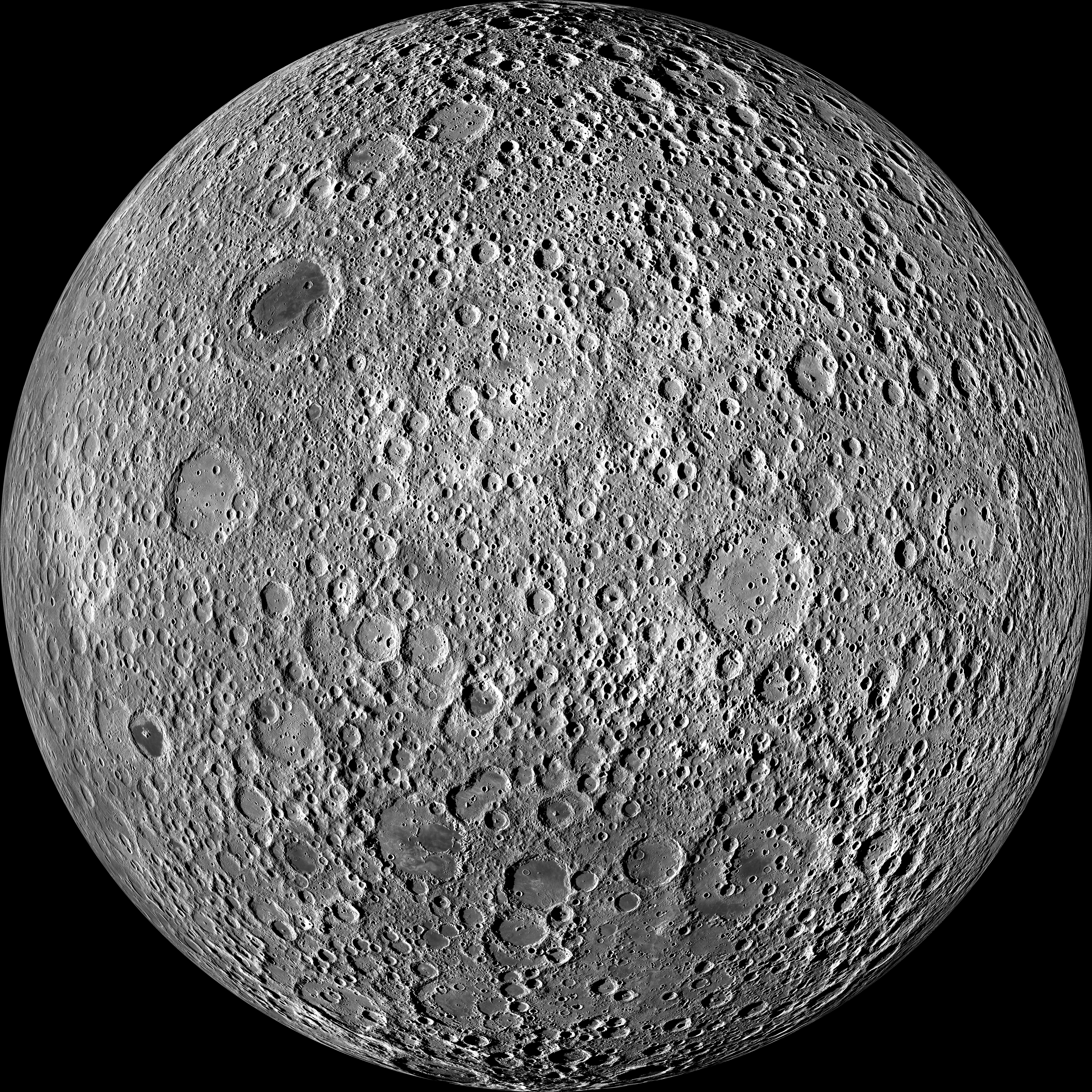|
Chang'e-2
Chang'e 2 (; ) is a Chinese unmanned lunar probe that was launched on 1 October 2010. It was a follow-up to the Chang'e 1 lunar probe, which was launched in 2007. Chang'e 2 was part of the first phase of the Chinese Lunar Exploration Program, and conducted research from a 100-km-high lunar orbit in preparation for the December 2013 soft landing by the Chang'e 3 lander and rover. Chang'e 2 was similar in design to Chang'e 1, although it featured some technical improvements, including a more advanced onboard camera. Like its predecessor, the probe was named after Chang'e, an ancient Chinese moon goddess. After completing its primary objective, the probe left lunar orbit for the Earth–Sun Lagrangian point, to test the Chinese tracking and control network, making the China National Space Administration the third space agency after NASA and ESA to have visited this point. It entered orbit around L2 on 25 August 2011, and began transmitting data from its new position in September 201 ... [...More Info...] [...Related Items...] OR: [Wikipedia] [Google] [Baidu] |
4179 Toutatis
4179 Toutatis, provisional designation , is an elongated, stony asteroid and slow rotator, classified as a near-Earth object and potentially hazardous asteroid of the Apollo asteroid and Alinda asteroid groups, approximately 2.5 kilometers in diameter. Discovered by French astronomer Christian Pollas at Caussols in 1989, the asteroid was named after Toutatis from Celtic mythology. Toutatis is also a Mars-crosser asteroid with a chaotic orbit produced by a 3:1 resonance with the planet Jupiter, a 1:4 resonance with the planet Earth, and frequent close approaches to the terrestrial planets, including Earth. In December 2012, Toutatis passed within about 18 lunar distances of Earth. The Chinese lunar probe Chang'e 2 flew by the asteroid at a distance of 3.2 kilometers and a relative velocity of 10.73 km/s. Toutatis approached Earth again in 2016, but will not make another notably close approach until 2069. Properties Toutatis was first sighted on 10 February 1934, a ... [...More Info...] [...Related Items...] OR: [Wikipedia] [Google] [Baidu] |
Chinese Lunar Exploration Program
The Chinese Lunar Exploration Program (CLEP; ), also known as the Chang'e Project () after the Chinese moon goddess Chang'e, is an ongoing series of robotic Moon missions by the China National Space Administration (CNSA). The program incorporates lunar orbiters, landers, rovers and sample return spacecraft, launched using Long March rockets. Launches and flights are monitored by a telemetry, tracking, and command (TT&C) system, which uses radio antennas in Beijing and antennas in Kunming, Shanghai, and Ürümqi to form a VLBI antenna. A proprietary ground application system is responsible for downlink data reception. Ouyang Ziyuan, a geologist, chemical cosmologist, and the program's chief scientist, was among the first to advocate the exploitation not only of known lunar reserves of metals such as titanium, but also of helium-3, an ideal fuel for future nuclear fusion power plants. Ye Peijian serves as the program's chief commander and chief designer. Scientist Sun Jia ... [...More Info...] [...Related Items...] OR: [Wikipedia] [Google] [Baidu] |
China National Space Administration
China National Space Administration (CNSA; ) is the government agency of the People's Republic of China that is responsible for civil space administration and international space cooperation, including organizing or leading foreign exchanges and cooperation in the aerospace field. An administrative agency under the Ministry of Industry and Information Technology, its headquarters are located in Haidian, Beijing. Founded in 1993, CNSA has pioneered a number of achievements in space for China despite its relatively short history, including becoming the first space agency to land on the far side of the Moon with Chang'e 4, bringing material back from the Moon with Chang'e 5, and being the second agency who successfully landed a rover on Mars with Tianwen-1. As the governing body of civil space activities, China National Space Administration does not execute any space program. The China Aerospace Science and Technology Corporation executes China's state space programs instead. T ... [...More Info...] [...Related Items...] OR: [Wikipedia] [Google] [Baidu] |
Lunar Deity
A lunar deity or moon deity is a deity who represents the Moon, or an aspect of it. These deities can have a variety of functions and traditions depending upon the culture, but they are often related. Lunar deities and Moon worship can be found throughout most of recorded history in various forms. Moon in religion and mythology Many cultures have implicitly linked the 29.5-day lunar cycle to women's menstrual cycles, as evident in the shared linguistic roots of "menstruation" and "moon" words in multiple language families. This identification was not universal, as demonstrated by the fact that not all moon deities are female. Still, many well-known mythologies feature moon goddesses, including the Greek goddess Selene, the Roman goddess Luna, and the Chinese goddess Chang'e. Several goddesses including Artemis, Hecate, and Isis did not originally have lunar aspects, and only acquired them late in antiquity due to syncretism with the de facto Greco-Roman lunar deity Selene/Luna. ... [...More Info...] [...Related Items...] OR: [Wikipedia] [Google] [Baidu] |
Chang'e 5
Chang'e 5 () was the fifth lunar exploration mission of the Chinese Lunar Exploration Program, and China's first lunar sample-return mission. Like its predecessors, the spacecraft is named after the Chinese moon goddess Chang'e. It launched at 20:30 UTC on 23 November 2020 from Wenchang Spacecraft Launch Site on Hainan Island, landed on the Moon on 1 December 2020, collected ~ of lunar samples (including from a core ~1 m deep), and returned to the Earth at 17:59 UTC on 16 December 2020. Chang'e-5 was the first lunar sample-return mission since the Soviet Union's Luna 24 in 1976. The mission made China the third country to return samples from the Moon after the United States and the Soviet Union. Overview The Chinese Lunar Exploration Program has four phases, with incremental technological advancement: * Phase one: orbiting the Moon, completed by Chang'e 1 in 2007 and Chang'e 2 in 2010. * Phase two: soft landing and deploying rover on the Moon, completed by Chang'e 3 (20 ... [...More Info...] [...Related Items...] OR: [Wikipedia] [Google] [Baidu] |
Chang'e 4
Chang'e 4 (; ) is a robotic spacecraft mission, part of the second phase of the Chinese Lunar Exploration Program. China achieved humanity's first soft landing on the far side of the Moon, on 3 January 2019. A communication relay satellite, , was first launched to a halo orbit near the Earth–Moon L2 point in May 2018. The robotic lander and ''Yutu-2'' () rover were launched on 7 December 2018 and entered lunar orbit on 12 December 2018, before landing on the Moon's far side. The mission is the follow-up to Chang'e 3, the first Chinese landing on the Moon. The spacecraft was originally built as a backup for Chang'e 3 and became available after Chang'e 3 landed successfully in 2013. The configuration of Chang'e 4 was adjusted to meet new scientific and performance objectives. Like its predecessors, the mission is named after Chang'e, the Chinese Moon goddess. In November 2019, Chang’e 4 mission team was awarded Gold Medal by the Royal Aeronautical Society. In October ... [...More Info...] [...Related Items...] OR: [Wikipedia] [Google] [Baidu] |
SpaceNews
''SpaceNews'' is a print and digital publication that covers business and political news in the space and satellite industry. ''SpaceNews'' provides news, commentary and analysis to an audience of government officials, politicians and executives within the space industry. ''SpaceNews'' details topics in civil, military and space and the satellite communications business. ''SpaceNews'' covers important news in North America, Europe, Asia, Africa, the Middle East and South America from NASA, the European Space Agency, and private spaceflight firms such as Arianespace, International Launch Services, SpaceX and United Launch Alliance. The magazine regularly features profiles on relevant and important figures within the space industry. These profiles have featured numerous government leaders, corporate executives and other knowledgeable space experts, including NASA administrators Richard Truly, Daniel Goldin, Sean O’Keefe, Michael Griffin and Charles Boldin. Founded in 1989, '' ... [...More Info...] [...Related Items...] OR: [Wikipedia] [Google] [Baidu] |
Xinhua News Agency
Xinhua News Agency (English pronunciation: )J. C. Wells: Longman Pronunciation Dictionary, 3rd ed., for both British and American English, or New China News Agency, is the official state news agency of the People's Republic of China. Xinhua is a ministry-level institution subordinate to the State Council and is the highest ranking state media organ in China. Xinhua is a publisher as well as a news agency. Xinhua publishes in multiple languages and is a channel for the distribution of information related to the Chinese government and the ruling Chinese Communist Party (CCP). Its headquarters in Beijing are located close to the central government's headquarters at Zhongnanhai. Xinhua tailors its pro-Chinese government message to the nuances of each audience. Xinhua has faced criticism for spreading propaganda and disinformation and for criticizing people, groups, or movements critical of the Chinese government and its policies. History The predecessor to Xinhua was the R ... [...More Info...] [...Related Items...] OR: [Wikipedia] [Google] [Baidu] |
JAXA
The is the Japanese national air and space agency. Through the merger of three previously independent organizations, JAXA was formed on 1 October 2003. JAXA is responsible for research, technology development and launch of satellites into orbit, and is involved in many more advanced missions such as asteroid exploration and possible human exploration of the Moon. Its motto is ''One JAXA'' and its corporate slogan is ''Explore to Realize'' (formerly ''Reaching for the skies, exploring space''). History On 1 October 2003, three organizations were merged to form the new JAXA: Japan's Institute of Space and Astronautical Science (ISAS), the National Aerospace Laboratory of Japan (NAL), and National Space Development Agency of Japan (NASDA). JAXA was formed as an Independent Administrative Institution administered by the Ministry of Education, Culture, Sports, Science and Technology (MEXT) and the Ministry of Internal Affairs and Communications (MIC). Before the merger, ISA ... [...More Info...] [...Related Items...] OR: [Wikipedia] [Google] [Baidu] |
NASA
The National Aeronautics and Space Administration (NASA ) is an independent agency of the US federal government responsible for the civil space program, aeronautics research, and space research. NASA was established in 1958, succeeding the National Advisory Committee for Aeronautics (NACA), to give the U.S. space development effort a distinctly civilian orientation, emphasizing peaceful applications in space science. NASA has since led most American space exploration, including Project Mercury, Project Gemini, the 1968-1972 Apollo Moon landing missions, the Skylab space station, and the Space Shuttle. NASA supports the International Space Station and oversees the development of the Orion spacecraft and the Space Launch System for the crewed lunar Artemis program, Commercial Crew spacecraft, and the planned Lunar Gateway space station. The agency is also responsible for the Launch Services Program, which provides oversight of launch operations and countdown management f ... [...More Info...] [...Related Items...] OR: [Wikipedia] [Google] [Baidu] |
Asteroid
An asteroid is a minor planet of the inner Solar System. Sizes and shapes of asteroids vary significantly, ranging from 1-meter rocks to a dwarf planet almost 1000 km in diameter; they are rocky, metallic or icy bodies with no atmosphere. Of the roughly one million known asteroids the greatest number are located between the orbits of Mars and Jupiter, approximately 2 to 4 AU from the Sun, in the main asteroid belt. Asteroids are generally classified to be of three types: C-type, M-type, and S-type. These were named after and are generally identified with carbonaceous, metallic, and silicaceous compositions, respectively. The size of asteroids varies greatly; the largest, Ceres, is almost across and qualifies as a dwarf planet. The total mass of all the asteroids combined is only 3% that of Earth's Moon. The majority of main belt asteroids follow slightly elliptical, stable orbits, revolving in the same direction as the Earth and taking from three to six years to comple ... [...More Info...] [...Related Items...] OR: [Wikipedia] [Google] [Baidu] |
CNSA
China National Space Administration (CNSA; ) is the government agency of the People's Republic of China that is responsible for civil space administration and international space cooperation, including organizing or leading foreign exchanges and cooperation in the aerospace field. An administrative agency under the Ministry of Industry and Information Technology, its headquarters are located in Haidian District, Haidian, Beijing. Founded in 1993, CNSA has pioneered a number of achievements in space for China despite its relatively short history, including becoming the first space agency to land on the far side of the Moon with Chang'e 4, bringing material back from the Moon with Chang'e 5, and being the second agency who successfully landed a rover on Mars with Tianwen-1. As the governing body of civil space activities, China National Space Administration does not execute any space program. The China Aerospace Science and Technology Corporation executes China's state space pr ... [...More Info...] [...Related Items...] OR: [Wikipedia] [Google] [Baidu] |





